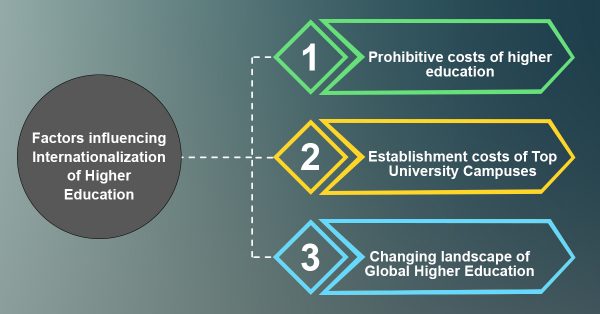Internationalization of Indian Higher Education
[GS Paper 2 - Health and Education]

Context – The 2020 National Education Policy (NEP) was a pathbreaking moment in the annals of Indian higher education. The policy envisions a complete overhaul and re-energizing of the higher education system.
The Internationalization of Higher Education refers to the various measures to be taken by the Indian Government to promote India as a global study destination.
The recently announced University Grants Commission (Setting up and Operation of Campuses of Foreign Higher Educational Institutions in India) Regulations, 2023, have re-ignited debates on the internationalization of Indian higher education.

Factors influencing Internationalization of Higher Education
- Prohibitive costs of higher education – Indian students must pay approximately Rs 70 lakh per annum to study at Harvard, Yale or Stanford and over Rs 55 lakh per annum to study at Oxford or Cambridge. Tuition fees alone would be about 15 times more expensive than Indian private universities. The new proposal vitiates the NEP’s vision of equity and inclusion as it envisages higher education only for the super-rich.
- Establishment costs of Top University Campuses – The vision of uniform academic standards in both the parent university and its international campus is a noble aspiration. However, the reality is international campuses have become a second-rate option, primarily accessible to those unable to get admission to the main campus. The quality and excellence in teaching and research on overseas campuses cannot match those in their primary location.
- Changing landscape of Global Higher Education – The idea of brick-and-mortar international campuses has given way to building solid partnerships, student and faculty mobility, exchange and immersion programmes, joint teaching and research opportunities, collaborative conferences and publications and the development of online and blended degree programmes. The global thinking around international collaborations has changed.
Steps to become Global Leader in International Education
- Greater autonomy to Indian universities and Institutions of Eminence – Indian universities, both public and private, are generally highly regulated and poorly governed. The ingrained institutional habit of regulatory bodies instructing universities on what they should be doing must stop.
- Establishment of Global-Oriented Universities – Establish global universities in India led by the public and the private sector to cater to the needs and aspirations of international students. India’s Gross Enrolment Ratio (GER) is lopsided. The national GER is approximately 22 per cent but there are states, such as Tamil Nadu, with a GER of 52 per cent. We must build more public and private universities across the country, with greater autonomy, resources and better governance structures, minimizing the role of the regulatory bodies.
- More resources to all the Indian universities – Indian universities face acute resource scarcity. The NEP has envisaged a six per cent annual investment in higher education and a National Research Foundation to allocate additional resources.
- Breaking the barriers, bias and prejudices and hierarchy – The NEP envisages breaking the long-standing barriers between public and private institutions. But many biases and prejudices persist. An institutionalized hierarchy in the Indian higher education system replicates the caste system. First, the IITs and the IIMs are placed high in the pecking order, followed by the central universities. Next come the IISERs, NITs and much lower down are the state public universities.
- Establishment of a progressive regulatory ecosystem – Much more than reforms in the education sector will be needed if India is to become a sought-after international destination for students from developing countries. Government must reform its visa processes and the FRRO registration procedures. There must be a significant improvement in the quality of infrastructure and hostels on university campuses.
What should be India’s Approach?
- Focus on becoming a global higher education destination in our own right – Instead of enabling the creation of international campuses of universities from developed countries, we need to focus on becoming a global higher education destination in our own right.
- Assume leadership role to realize Vishwaguru aspiration – We will not realize the Vishwaguru aspiration by inviting prestigious foreign universities to locate campuses. We must assume the leadership role we had over 2,000 years ago when Nalanda, Takshashila, Vallabhi and Vikramshila attracted faculty and students from around the world.
- High-quality education at an affordable cost – We can be truly global leaders in providing high-quality education at an affordable cost. Likewise, we can produce high-quality research at a relatively lower cost.
Conclusion
The vision of India becoming a Vishwaguru cannot be achieved by outsourcing Indian higher education to international universities. Instead of enabling the creation of international campuses of universities from developed countries, it must focus on becoming a global higher education destination in its own right.





.png)



